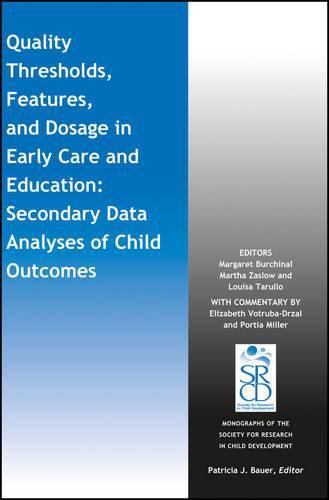Readings Newsletter
Become a Readings Member to make your shopping experience even easier.
Sign in or sign up for free!
You’re not far away from qualifying for FREE standard shipping within Australia
You’ve qualified for FREE standard shipping within Australia
The cart is loading…






The questions of whether preschool children benefi t more strongly when early care and education (ECE) is at or above a threshold of quality, has specifi c quality features, and/or is of longer duration were examined in secondary data analyses of eight large ECE studies. These issues are pivotal in recent ECE policies designed to improve school readiness skills, especially for children from low-income families. Threshold analyses examined whether quality had stronger associations with gains in child outcomes in settings with high levels of quality than those with lower quality. Features analyses considered whether specific measures of instruction and of teacher-child interaction were more predictive of gains than global quality measures. Dosage analyses tested whether the amount of in ECE settings or in instruction in specific content areas predicted child outcomes. Threshold analyses provided some evidence for thresholds in measures of instructional quality in relation to reading and language skills in meta-analyses based on a prior-selected cut-points and, less clearly, in empirical methods designed to identify cut-points. Analyses examining quality features indicated stronger prediction of gains in child outcomes from interaction-specific and content-specific measures than from global measures. Propensity score analyses indicated that children had higher school readiness skills at the end of preschool and in kindergarten if they had two years of Head Start compared to one year. Finally, dosage analyses indicated that children showed larger gains in content areas when teachers spent more time providing instruction in those areas or when children had fewer absences. No evidence of quality by quantity interactions emerged. Implications of the thresholds findings for ECE policies such as Quality Rating and Improvement Systems are discussed. The dosage findings support the growing trend toward more than one year of access to publicly funded preschool programs for low-income children as well as increased focus on the content of ECE activities and instruction to enhance language, literacy, and math skills.
$9.00 standard shipping within Australia
FREE standard shipping within Australia for orders over $100.00
Express & International shipping calculated at checkout
The questions of whether preschool children benefi t more strongly when early care and education (ECE) is at or above a threshold of quality, has specifi c quality features, and/or is of longer duration were examined in secondary data analyses of eight large ECE studies. These issues are pivotal in recent ECE policies designed to improve school readiness skills, especially for children from low-income families. Threshold analyses examined whether quality had stronger associations with gains in child outcomes in settings with high levels of quality than those with lower quality. Features analyses considered whether specific measures of instruction and of teacher-child interaction were more predictive of gains than global quality measures. Dosage analyses tested whether the amount of in ECE settings or in instruction in specific content areas predicted child outcomes. Threshold analyses provided some evidence for thresholds in measures of instructional quality in relation to reading and language skills in meta-analyses based on a prior-selected cut-points and, less clearly, in empirical methods designed to identify cut-points. Analyses examining quality features indicated stronger prediction of gains in child outcomes from interaction-specific and content-specific measures than from global measures. Propensity score analyses indicated that children had higher school readiness skills at the end of preschool and in kindergarten if they had two years of Head Start compared to one year. Finally, dosage analyses indicated that children showed larger gains in content areas when teachers spent more time providing instruction in those areas or when children had fewer absences. No evidence of quality by quantity interactions emerged. Implications of the thresholds findings for ECE policies such as Quality Rating and Improvement Systems are discussed. The dosage findings support the growing trend toward more than one year of access to publicly funded preschool programs for low-income children as well as increased focus on the content of ECE activities and instruction to enhance language, literacy, and math skills.